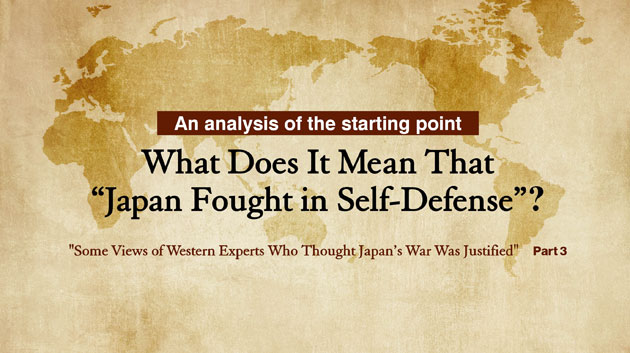What Does It Mean That “Japan Fought in Self-Defense”?
"Some Views of Western Experts Who Thought Japan's War Was Justified" Part 3
“Their purpose, therefore, in going to war was largely dictated by security.”
This is what Douglas MacAurthur said at a hearing of the US Senate Armed Services and Foreign Relations Committees in 1951, stating that the Japanese rationale for war was effectively in self-defense, and added that one of the greatest mistakes that the United States had made in the 20th century was to allow the spread of communism.
At the Tokyo Trial, Hideki Tojo had consistently warned of the dangers of communism. He asserted that if Manchuria were not defended, communism would spread throughout Asia, and that communist forces were working behind the scenes during the Manchurian incident.
After the Russian Revolution of 1917, the Soviets abolished the monarchy by wiping out the entire imperial family, which was seen as a threat by extension to Japan and its imperial family. Furthermore, they were purging dissidents and cracking down on human rights in the Soviet Union.
Japan then signed the “Anti-Comintern Pact” with Germany in 1936 to prevent communism from spreading. However, after the war, the Allied Powers condemned Japan and Germany saying that the treaty showed a clear sign of intent to invade the Soviet Union.
But in reallity, history shows that only two years after the Tokyo Trial, the Korean War erupted and the Korean Peninsula was split between Communist North Korea and a South Korea friendly to the West.
The United States had finally realized the threat posed by the Soviet Union. But by then, China had been lost to communism, and the United States has since been paying the price, of not realizing Japan’s security concerns vis-à-vis the spread of communism in Asia, by standing off against communist forces around the world.
US Interests in China
Since the Meiji Restoration, Japan sought to protect its sovereignty to prevent colonization by Western powers. In particular, the Korean Peninsula and Manchuria were critical geopolitical buffer states needed to prevent a south-ward expansion by Russia.
However, the Korean Peninsula, at that time, was a Chinese client-state, and China itself had lost control of its maritime borders after losing the Opium War. Thus, in an effort to prevent Russian invasion of the Korean Peninsula and the Manchurian territory, Japan fought the Sino-Russo-Japanese War. Subsequently, Japan’s rule over Korea and Manchuria was recognized, through treaties, by the international community.
However, after the First World War, the United States, which seeked to expand its interests in China, began a concerted effort of Japan-bashing (see below chronology). At the Washington Conference in 1921, Japan was forced to accept the lop-sided “Washington Naval Treaty,” and subsequently in 1924 the United States passed the clearly racist “Asian Exclusion Act,” and kicked Japanese nationals out of the country.
Barbarism of the National Revolutionary Army
In mainland China too, anti-Japanese movement by the Chinese people was on the rise. At the time, China had broken up into a collection of armed factions to the point where it was difficult to determine who held the authority to conduct diplomatic negotiations. It was during this time that the Soviet Union infiltrated China to incite anti-Japanese sentiments.
In cases such as the Nanking Incident, Hankou Incident, or the Marco Polo Bridge Incident, Japanese soldiers and Japanese civilians who were stationed in mainland China were the victims of assault, looting and murder. Notably, at the Tongzhou Incident that occurred in eastern Beijing in 1937, over 200 Japanese were brutally murdered.
While the Japanese military deployed troops after each incident to each time and defeat the National Revolutionary Army led by Chiang Kai-Shek, attacks such as the Shanghai Incident continued to take place. Since the Marco Polo Bridge Incident, Japan had called for peace numerous times, only to be ignored by the National Revolutionary Army.
However, behind the scenes, it was United States and the United Kingdom who were supporting the National Revolutionary Army. In order to put an end to the conflict, Japan decided to take the capital, Nanking.
Economic Pressure Is Also a Form of Invasion
To help Britain who had been at with Germany from since 1939, America was looking to join the conflict by starting a war with Japan who was an ally of Germany. To restrain Japan with their expanding war front in China, the United States had frozen the assets of Japanese-Americans. Cooperating with other countries, they put an embargo on steel, copper and tin, and in 1941 completely stopped the oil supply going to Japan. Having this “ABCD encirclement” (note) imposed on them, Japan, with their scarce resources, was economically isolated and was forced into a corner.
To deal a final blow, America confronted Japan with the Hull note. It demanded, among others, the immediate withdraw from Manchuria, ignoring the sacrifice and struggle Japan had gone through since the Meiji Restoration, and to ultimately come under the protection of the United States. Since this also meant the expansion of Soviet rule, so Japan had little choice but to go to war with America.
Japan was threatened by the Soviet Union for decades and was cornered in by America. In light of this, it becomes clear that the war was fought in self-defense to preserve their independence.
Furthermore, the Secretary of State, Kellogg, who compiled authored the “Pact of Paris” in 1928, stated at the U.S. Congress, “not only to cross borders and attack, but to put enormous economic pressure can also be regarded as a war of aggression.” Due to the ABCD encirclement, Japan’s trade volume dropped to one-third. It should thus be regarded that America had made an act of war.




















